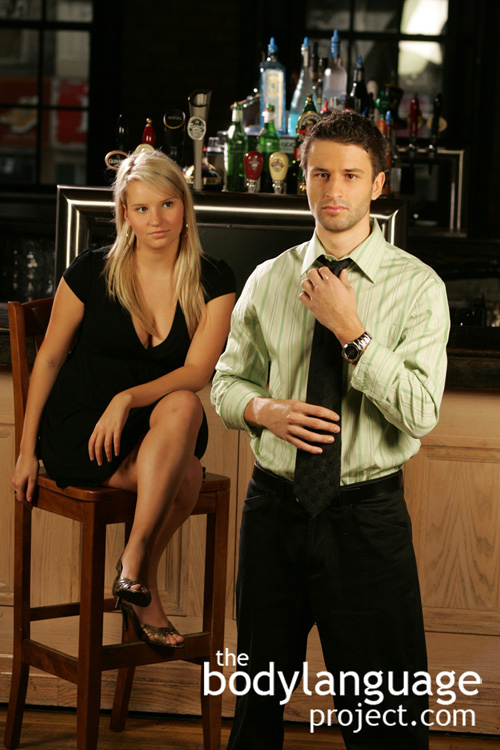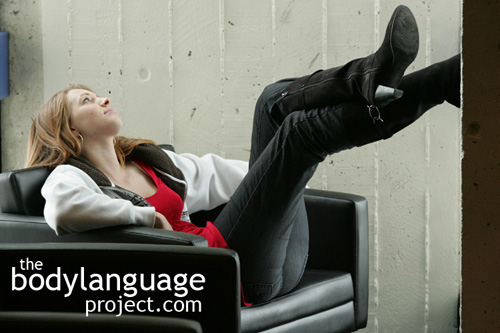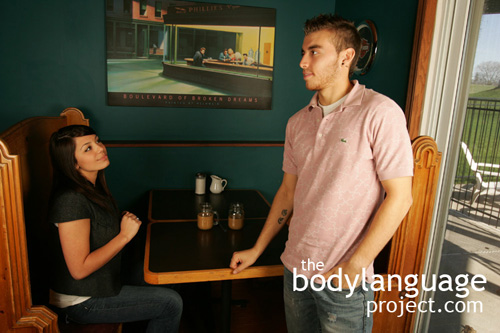Touch reduction is usually accompanied with stressful questions or when information is presented that creates anxiety. Closeness can also be useful when assessing someone because it will invoke distancing desires. When talking with a spouse or child, sit as close as that which you are accustomed to before taking up serious matters. If someone is hiding something, they will usually push away or even stand up looking for ways to exit or change the subject. Holding the hand of a child can be particularly useful when discussing matters of dishonesty. If they wish to exit the discussion, they will try to tug their hand away.
Tag Archive for Torso
Remaining Uncommitted
by Chris Site Author • March 6, 2013 • 0 Comments

When people tell the truth they will usually show extra enthusiasm and commit to their story. Liars often start off the same way, but quickly trail off.
Liars will motion without emphasis, or describe events by trailing off or use weak statements. They might limit arm and hand movement by clasping them together or locking them down on an armrest with such force they turn their knuckles white. The hands might be put out of sight in pockets or under a table where they can’t be read. Reduced movement can be seen throughout the body, not just in the hands. The entire body including the head, arms, feet, and torso can seem to lock in place. People that are telling the truth spend a lot of time and energy in efforts to make the facts known which comes across in their body language and gesturing. Truth tellers are happy to spend as much time as necessary to get everything right. They will often add more detail than required and go over it again and again if necessary. Not emphasizing is linked to the freeze response where the mind clams the body shut and reduces movement so as to draw less attention to it. What is important in lie detection is to compare cues from a baseline. That is, if someone suddenly drops emphasis then you know they’ve lost interest in the topic or are lying. In either case, it will have provided useful information to the body language reader.
In writing this passage, I had just reviewed a video (see bottom posted on the web of a baseball game in which a player leaped head-over-feet clear over the catcher as he came to homeplate to score a run. The catcher, stuck in a fear response, failed to tag the runner. Baseball has an interesting tradition where it is customary for the runner to body-check the catcher at homeplate as he tries to tag for an out. While the catcher braced and ducked with his elbow up to make the tag, the runner jumped over the catcher landing on home plate. The catcher stuck with his elbow up in defense could only convince his mind to bring his arm just close enough to miss the tag! Because his mind feared the body check, he wasn’t able to follow through with what he intended. While this is an interesting fear based response what follows is even more interesting since it helps us read liars. The catcher, realizing he failed to get the out, quickly turns to pursue the runner. One must ask why he would track the runner down if he made the tag? Obviously he hadn’t! But more important that this, is that we know that he knows that he didn’t make the tag! This means that any nonverbal language following the lack of tag, should he dispute it, is read as lying language. To state his case, the catcher chats with the umpire by raising his arms showing how he made the tag. What is revealing, however, is that the catcher only slightly raises his arms instead of doing it with emphasis. Instead of showing the gesture over and over again, the catcher just raises his arms once as if to make a casual rainbow motion with his arms. When his coach shows up with arms flaying and talking with enthusiasm, the catcher quietly exits! The catcher knows that he can’t make a case and so doesn’t put any effort into trying. The difference between the coach and the catcher, is that the catcher knows he’s lying, while the coach isn’t sure. Once more, the coach isn’t actually lying anyway, since he wasn’t there to feel the contact or lack thereof of the catchers mitt and the runner, he’s just acting out an inherent bias – he’s playing the role he was hired to do. Lack of commitment is an important cue to watch for when detecting lies so be careful to watch for it.
Dominant Body Language
by Chris Site Author • March 6, 2013 • 0 Comments
Establishing dominance and status are the main messages men deliver to establish attraction with women and there are a variety of methods to do so. Fashion is one aspect of status and it includes expensive watches and suites, polished shoes and being well groomed. Status also comes across through body language. Open postures, legs spread apart, arms uncrossed and keeping the hands away from the face. Alpha men display alpha traits because life has treated them well. Good posture also shows that life hasn’t taken advantage of him and the weight of the world isn’t holding him down.
The torso’s of dominant men is firm and still, they will use their arms to punctuate points, but keep them relatively inactive. Dominant men only rarely raise their arms above the level of their belt. Speaking slowly with a calm voice also shows dominance. The fewer words used, the more emphasis is placed on what words are used. Instead of rambling on, men should use more pauses and allow their minds to catch up. Alpha men speak slowly, almost carefully. They choose their words wisely and avoid fillers such as “ummm” and “ahhh.” Taking up space is also part of dominant body language. Having the arms spread wide while on a sofa and the legs apart gives the impression that men are relaxed and also larger than they actually are.
The Types Of Hugs
by Chris Site Author • March 6, 2013 • 6 Comments
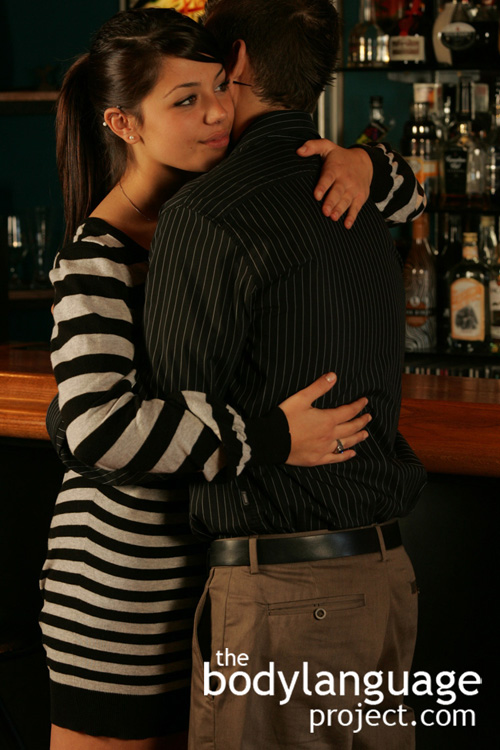
An intimate hug is obvious by checking the distance between the hips. The smaller the distance, the more intimacy is present. When we hug grandma, we might only touch shoulders by leaning in!
There are two types of hugs and each one indicates a different level of intimacy. The first is called the “full body hug” and is reserved for sexual partners. This type of hug is characterized by full chest to chest and hip to hip contact. Since the bodies are so tightly pressed together, the genitals might also touch incidentally. The second type of huge is the “light social hug”, the main hug for acquaintances and friends, and happens when the shoulders come together as the torso hunches forward, but the hips remain apart.
Hugs have a secondary hidden meaning as well. The longer the hug, the more intimate and affectionate is the relationship. A pat at the end of the hug indicates that one party would like to “submit” from the hug and terminate it. This gesture is similar to the actions wrestlers to do “tap out.” Taps also show feigned or meaningless hugs, or even unwelcome hugs, especially if the tap happens early. Most people think tapping while hugging shows comfort, but sexually romantic partners and close family members do not pat, they embrace deeply and squeeze tight.
The hips, during a hug, also have a very significant hidden meaning. That meaning is conveyed directly through the distance to which they remain separated and that distance tells us a lot about the type of relationship two people have. Hugs that happen between family and friends will have at least six inches between the pelvic regions of each person, whereas hugs from lovers have no, or very little space between the hips. The torsos of lovers also move tightly into each other’s intimate zones enveloping each other. The degree to which hips remain separate, or rear-ends are extended outward, whichever you prefer, and the amount of contact that takes place in the upper chest, tells us what degree of intimacy is present between huggers. Light hugs as we saw, can include only light shoulder contact, and in extreme light hugging, the bodies might not press together at all. The arms and hands might form a closed loop from shoulder to shoulder “around” them, but the chest and shoulders might only seem to move slightly closer, or seem to bob in quickly before moving out, not coming any closer than a foot. The hidden language of hugs can tell us a lot about the relationships around us, even potentially juicy ones like those brewing amongst staff members. A careful eye at the next social affair might uncover some cheeky relationships!
The Security Blanket
by Chris Site Author • March 6, 2013 • 0 Comments
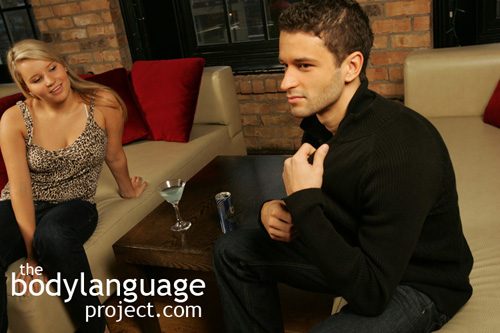
Playing with a sleeve of cufflink is a leaked gesture because it replaces a full arm cross but still provides the feeling of comfort.
As we get older we are taught that certain behaviours and habits are unacceptable. Carrying a security blanket, for example, while acceptable as a toddler is unbecoming in grade school so it is weaned. Perhaps as a by-product of our recent, in evolutionary terms at least, bipedalism, we’ve failed to fully adjust methods of keep our hands busy. Bipedalimsm is the term used to describe walking on two feet which is rare in the animal kingdom. When under pressure, our hands and arms are the first to feel out of place and give away our awkwardness. Even those that spend a lot of time in front of large audiences can still be found with “security blankets”, as it were whose purpose is to keep busy our free appendages.
The cuff link is a common choice for men attending formal affairs because it gives their hands a use instead of dangling awkwardly as they walk. Next time you see a televised awards show watch carefully as a presenter or an award winner make his way up to the stage, he just might show his awkwardness by fingering his cufflink. Reaching across the body in this way is also an abbreviated arm cross since the hands come out in front of the body forming a barrier, in this case a loose loop.

A purse can be used as a shield to protect the torso. If you want to know how she really feels about you, just measure much she trusts you around her purse.
This type of body language is defined as ‘leaked’ because consciously the person is trying to prevent it from happening, but their conscious mind is only successful at blocking a more obvious gesture by replacing it with one that is slightly less pronounced. The gestures are also considered “masked arm crosses” because they create a barrier-effect protecting the body, but aren’t full blow arm crosses. Other forms of gestures that fall in the same family include holding or clutching a bag, checking the contents of a bag or briefcase where the arms must cross the body, playing with a bracelet, watch or shirt button and holding a drink with both hands. Any sort of motion that allows one hand or arm to cross the center of the body, or where a crutch object is sought that otherwise serves little or no appropriate purpose, qualifies as a security blanket. To those aware of the cue, it is a very easy ‘tell’ to catch, because there really is no purpose for the behaviour aside from tension relief.
What to know if a women trust you? See how she reacts around her handbag! The handbag is a very personal item for women and she uses it as an item of security. When nervous or out of place, she can dive into her bag and checks its contents so as to symbolically connects her to the comforts of home and exempt her from outside interruptions. In other words, while she checks her back, she’s busy, don’t bother her! Handbags give women something to grasp onto and hold especially if they feel particularly self-conscious or insecure and will feel naked without it. On the other hand, if she allows the handbag contents to be viewed by a potential male suitor, or trusts him to guard it, you can bet that she is willing to explore a relationship. Women are personally connected to their handbags!
Summary – Chapter 8
by Chris Site Author • March 5, 2013 • 0 Comments
This chapter was focused on dominant and submissive gestures and how they can be used to reach specific goals depending on the situation. One of those goals was conflict avoidance by reducing body size. We found that melting into the background by “sinking in the chair” or pulling the arms inward, pulling the shoulders down and rounding them, hunching in, pulling the chin in and pulling the legs or knees closer together can help to send a non-threatening signal and calm an attacker. Next we looked at how height relates to dominance and spelled out tactics to put ourselves at an advantage be it by taking up a seated position (to level ourselves) or taking to an elevated stage or position. We saw in this chapter that relaxed body language signals ownership and confidence so we should look for a lack of muscle tension, freely moving hands, feet and torso, along with open body postures, to read which people are most confident.
We also found that the head signals nonverbally, for example, the headshake signals a negative thought, whereas the head nod can mean agreement such as in the west or can mean submission or even that a speaker is being heard in Japan, head down represents judgment or a negative thought when accompanied by similar cues in cluster, head tilted shows interest and head back means disapproval.
We discovered that dominant positions are generally also considered open postures and submissive postures are also usually considered closed postures. This theory allowed us to conclude that the chair straddler was both opened and therefore dominant, but also cowardly because the back of the chair formed a barrier from where he or she might throw figurative arrows or spears. We found that legs spread is a dominant gesture and of degree; the greater the spread the more dominant and at some point outright offensive, as in the case of having the leg over the arm of a chair. The full body steeple where both hands are up and behind the head while seated with or without the figure-four leg cross is both confident and dominant, but also depicts a relaxed disposition. We covered that titling backwards in the chair is dominant and casual, having the hands on hips is to imitate a peacock and appear larger and more attractive dominant or in charge, and that the cowboy pose with thumbs in belt loops popularized by old western’s is macho. We learned that the military man who exposes his torso with his hands, palm in palm to his back delineates power.
We then covered the importance of thumbs and how they show importance and superiority, how fences make great neighbours, and methods we display ownership one of which is by breaking social rules or via body language through control of facial expressions. We found that touching between men symbolizes power plays and social jostling, but between men and women, usually signifies sexual interest and that light touching helps gain compliance even from strangers. We also outlined why we should avoid filling our language with junk instead of simply punctuating a point, how talking fast makes us appear insecure or nervous unlike Barack Obama and how low-pitched masculine voices increased ratings of men’s physical and social dominance.
Relaxed Body Language
by Chris Site Author • March 5, 2013 • 0 Comments
Identifying relaxed body language helps us find people that belong, or that feel they belong, in a given situation. Those that are relaxed do so in environments they “own” and control and the higher is a persons’ status, the more diverse will be these environments, although situational novelty also plays a major role in comfort. Even low status people have a variety of locations in which they feel relaxed because being relaxed is a function of feeling that no threat is present and this is based largely on experience. Someone ridding a subway for the first time, for example, will be tensed and show rigid body postures like a coiled spring. They will be looking around at the subway signs and various indicators, and the people around them. It is impossible to be and look relaxed when the senses are on alert, when we’re keen to watch for signals of danger suspecting that all noises around us could indicate imminent danger. Someone that rides the subway daily won’t notice the signs and sounds around them, just like a highway driver zones out for the majority of the drive only to find out somehow he has arrived at his destination. Subway riders might even be so relaxed that they doze off on their route or become engrossed in a newspaper or magazine and miss their stop.
Relaxed body language is any body language that lacks muscle tension, the body is loose and the arms and legs move freely and naturally swaying with any motion. The torso may sag slightly to one side, or slump, but is not held by irregular tension. Thus, the body holds regular open body postures, with the arms and legs uncrossed. A leg might even be tucked under the body, to be sat on, showing that one is not prepared to leave and doesn’t expect to be caught off-guard. Breathing is steady and slow and can even become deep showing even more relaxation. Smiles happen in coordination with the eyes and the lips are not simply stretching across the face. The eyebrows are stable or move along with speech rather than frowning and the eyes gaze rather than stare and blink at a regular rate. The forehead will have no tension and we should watch for wrinkles which is an easy give-away to tension. Lines and wrinkles in the forehead quickly showing fear. Lastly, the skin colour is normal, not red showing embarrassment or anger, and isn’t pale with fear.
Sudden Changes In The Hands
by Chris Site Author • March 5, 2013 • 0 Comments
Hands can show real-time changes in an attitude. Imagine a couple sitting enjoying a romantic meal at a restaurant, with their hands bridging the gap between them as they sit facing one another hand-in-hand. The topic of conversation flows freely, but suddenly switches to a contentious issue, what would you imagine would happen to their hands? When there is disagreement between people, the hands are pulling inward and away from those we disagree with. This sort of behaviour can happen suddenly especially on a heated topic, but can also happen over time on issues that gradually show differences. When total disagreement is present, the body will even be withdrawn where the hands will rest on the lap. Taking the example of the couple above once again, imagine that only one of the two experiences a change in thought to the topic, their hands might remain outstretched in the center of the table and turn palm up as if to offer the idea to their partner as if to try to change their mind. Gradually the other might re-advance to join their hands once again or move them to their lap. As the argument fails, both parties hands might graduate away. If disagreement continues, feet might orient toward the door followed by torsos than finally their heads.
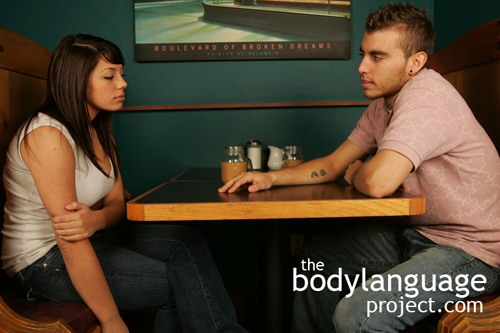
Arms are withdrawn when disagreement is high. These arms are busy protecting the torso in a single arm closed body posture – an ‘incomplete hug.’
Arms withdraw for a number of reasons but our subconscious mind tunes into our flight response and pulls hands in when we fear they will be hurt, and especially when they are hurt. When we touch a hot stove or hear a loud bang, our arms draw quickly into our bodies to protect them. This happens instantly with no ability to stop it. Likewise, our hands come in when we are worried or threatened despite a lack of physical threat. When our arms come in, our minds feel that they can block attacks better even when they are emotional in nature. Hands can be withdrawn for any number of reasons, not just disagreement, such as dishonesty. Honest hands are palm up, offering something to another person, or palm down in a confident authoritative position, but when hands are pulled away, they signal hidden thoughts of disagreement and lack of connectivity.
Hands can also suddenly change in terms of use of illustrators and seem to pause, stop or slow in their rate of use. Sudden cessation of gesticulation can indicate a freeze response due to being caught in a lie especially when the context warrants it. This is part of the flight or flight response as liars are trying to seem less noticeable. They are “hiding in plain sight” and to do this it is necessary to move less as movement attracts attention. Reducing expressiveness means fewer “tells” or so the lying mind thinks. When hands that are usually busy while talking according to a baseline, suddenly begin to slow, or become less expressive, it can signal a lack of enthusiasm or confidence for the topic. Whatever happens to the hands, when they suddenly change, we know that something internal has changed and it is usually tied directly to whatever is happening in the moment.
Ventral Displays
by Chris Site Author • March 5, 2013 • 0 Comments
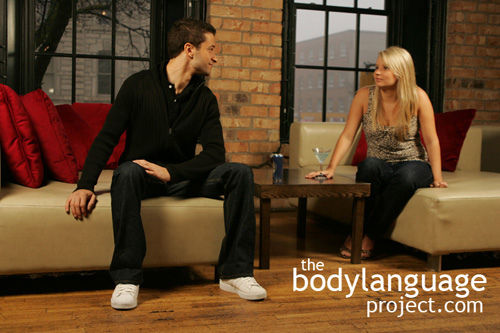
When the chest is turned away, this is called “ventral denial.” It says, “I don’t like what you’re saying.”
Torsos house important organs that are vital to keeping us alive. Our heart, lungs, liver, intestines and so forth are all easily accessible through a thin layer of skin, fat, muscle and sometimes ribs and a sternum although even these have spaces by which damage may be inflicted. Exposing our ventral side means that we trust we won’t be attacked. Laying on our backs is something we do only in our own houses because it exposes our bodies to attack and paralyzes us from defending ourselves.
Women, in the wrong company will feel particularly sensitive about exposing their breasts and both sexes will avoid displaying their genitals when nervous or timid. This is where arm and leg crossing is prevalent creating shields so as to reduce threatening exposure. Other times, bodies may turn away from people with whom we lack trust, or we may distance our torsos to give us a time and space buffer so that if a threat should be advanced, we have enough of a cushion to escape.
When in conversation people will orient their ventral side to those they trust the most and away from those they trust least. They’ll also favour those with whom they agree with most and away from people they disagree with or have contempt for. People can be seen changing their orientation more and more over the course of a conversation as ideas diverge. In dating, as women are turned off by an approach they will first shift their feet toward the exit, followed by the torso. If they wish to remain polite so as not to offend, they might keep their faces oriented toward their solicitor, yet the rest of their body, the important parts, will face away. Even slight disagreement can produce ventral shifts as bodies orient away from the speaker based on topics of lessor interest or topics we wish not do discuss.
Ventral distancing is also a nonverbal cue that indicates agreement. When people don’t like what they are hearing, they will slouch or lean backward to indicate that they aren’t seeing eye-to-eye on matters. On the other hand, when people agree, they will move toward each other to shrink the distance. When presenting a lecture, it’s easy to measure audience interest because those most keen will be sitting “at the edge of their seat” hanging onto every word. The bored or disinterested will be slouching or sitting low in their seats perhaps awkwardly to one side as if ready to take flight.
When we are reunited with loved ones we take part in hugs which is intimate precisely because the torsos are sandwiched together. We even move our arms away from our fronts so that we can get even closer. Children love to receive “raspberries” where air is blown onto their stomachs and will permit it because they trust their parents or family members. However, even with children they’ll “turn their backs on us” when they are upset with us as we enforce rules. This is a nonverbal way to show disagreement. Lovers in deep conversations will move closer to each other and face head on indicating a trust and showing no desire to leave or exit the situation which might happen by turning the torso away. Orienting the torso forward says that this is the direction in which someone is thinking about moving and when lovers do this, it means they wish to move into one another; to kiss. In a business context, people who agree with turn their bodies so they more closely face each other, even while sitting, and away from those whom they disagree with. This is called “ventral fronting” or “ventral denial.”
To use ventral language best, lean forward and drop the arms to the side when you wish to project agreement but when the opposite is desired feel free to side back in a chair or lean back or turn to the side and cross the arms. Making friends with all people is not always desirable especially when someone is malicious and unpopular. Being courteous all the time, to all people is a misuse of proper body language so use the nonverbal language that is most appropriate for the feelings you want to convey.
Introduction – Chapter 7
by Chris Site Author • March 5, 2013 • 0 Comments
Openness can sometimes be confused with simply being relaxed or intense, and to some degree this is true. For example, being open often means that attire is also relaxed, shirt collars are unbuttoned, ties removed, the pants might hang loose and certain articles like jackets might be removed. Full openness, therefore, is not always acceptable. Conversely, we might look at being open as simply a lack of holding closed cues. That is, having open cues is the exact same as not displaying closed cues and is the default position of the two. Being closed requires a certain amount of tensing of muscles and therefore effort so the default of most people is having an open mind. In other words, people are open, unless they say otherwise! It follows that there are far fewer cues to symbolize openness as opposed to closed, since being open is more of a passive state.
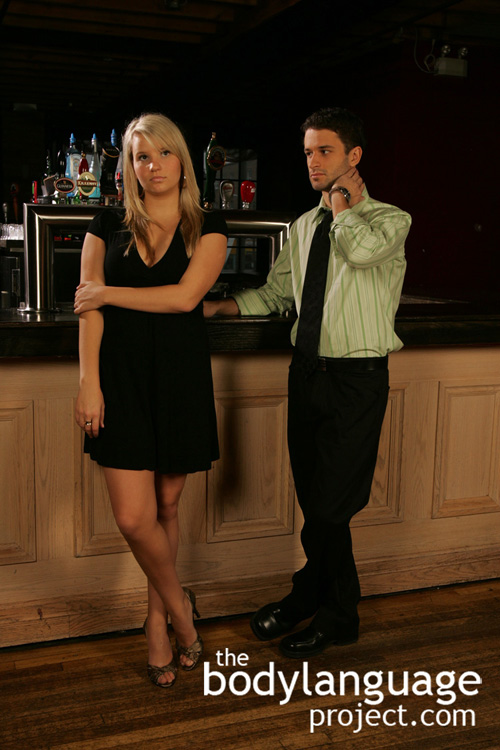
Closed body language happens whenever a part of our body crosses the center-line. Arms are shields that protect our torso from harm.
When closed postures are combined with other closed postures, the signal intended is made more obvious. For example, leg crossing in combination with arm crossing is much more potent than either alone. Add to this an expressionless face, turning away, and one is left to assume that communication is not welcomed at any level. On the other hand, we might be faced with someone who has their legs crossed but the arms are opened and honest. In this case, we might assume that it is a deliberate and conscious attempt to appear relaxed, when in fact the person might not be relaxed at all. It might be the case too, that someone has mixed feelings and is reserved at one level, but open at another level. Reading opened and closed body language is tricky business, but all cues are additive. Cues of the same origin, happening together, serve to strengthen an open or closed reading, but so too does conflicting cues. Conflicting cues tell us that someone has an internal reservation, made obvious through their mixed message.
It is fortunate for those of us who wish to modify our body language, that we have control of our conscious mind, since we then can modify our body language as desired.
Of course, since de-linking of our bodies and minds is difficult, these changes bring about inherent change in our attitudes as well. For example, it’s fairly easy to consciously carry open postures, such as palms up, arms and legs uncrossed, and hold active eye contact, however holding these postures necessarily leeches back into us creating open feelings.
In this chapter we will examine the vast array of open and closed body positions that we can use to come across as more or less open, as we desire. Naturally too, we will be able to identify this same body language in other people and use it to our advantage when reading them.


